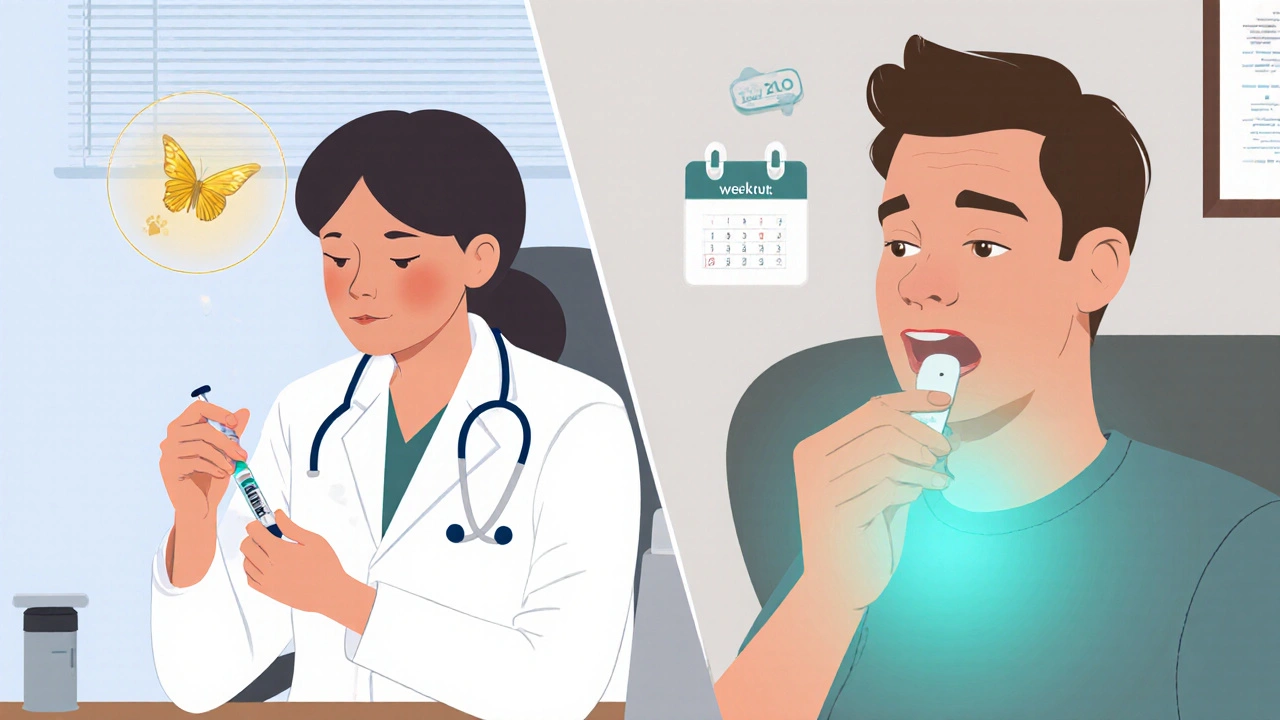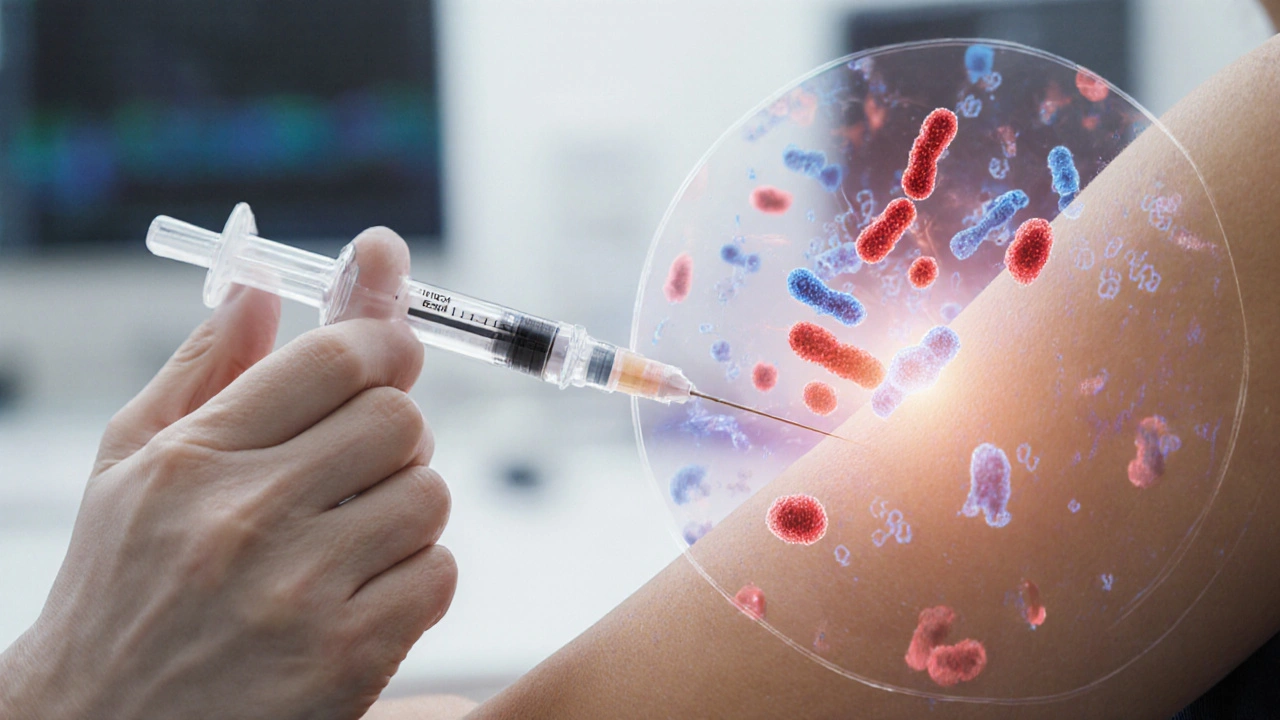Allergy Immunotherapy Cost Calculator
Your Current Costs
Treatment Options
Based on 3-year treatment course
When dealing with persistent allergies, Allergy Immunotherapy is a medical approach that re‑educates the immune system to tolerate specific allergens, leading to long‑term symptom relief. Unlike standard drugs that only mask symptoms, this therapy targets the root cause, helping the body build true tolerance.
People often wonder if a treatment that sounds like a vaccine can really change a condition like allergic rhinitis or asthma. The answer lies in how the immune system reacts to Allergens substances such as pollen, dust mites, pet dander or insect venom that trigger IgE‑mediated allergic responses. By exposing the body to tiny, controlled amounts of these triggers, immunotherapy gradually shifts the immune response away from the harmful IgE Antibodies proteins that bind allergens and activate mast cells, causing the classic sneeze, itch and wheeze cascade.
Key Takeaways
- Allergy immunotherapy addresses the underlying immune cause, not just symptoms.
- Both subcutaneous (injection) and sublingual (tablet/drop) forms are proven effective for allergic rhinitis, asthma and insect‑venom allergies.
- Benefits include reduced need for antihistamines and steroids, fewer asthma attacks, and lasting protection after the treatment course ends.
- Typical treatment lasts 3‑5 years, with a buildup phase followed by a maintenance phase.
- Safety profiles are good; most adverse events are mild local reactions.
Two delivery methods dominate the market today.
Subcutaneous Immunotherapy (SCIT) delivers the allergen extract via a series of injections under the skin, usually in a clinic setting. The buildup phase often requires weekly visits, then shifts to a monthly maintenance schedule. SCIT has a long track record and strong evidence for asthma control.
In contrast, Sublingual Immunotherapy (SLIT) places allergen tablets or drops under the tongue, allowing patients to self‑administer at home. SLIT offers greater convenience and eliminates the need for frequent clinic trips, making it popular for children and adults with busy lifestyles.
How Immunotherapy Works: The Science in Simple Terms
The process can be broken down into three core steps.
- Desensitization: Small allergen doses train Mast Cells immune cells that release histamine during an allergic reaction to become less reactive.
- Immune Shift: Over time, the body produces more IgG4 Antibodies a “blocking” antibody that competes with IgE, preventing the allergen from triggering mast cells.
- Tolerance: The immune system learns to view the allergen as harmless, leading to lasting relief even after therapy stops.
Clinical data consistently show that patients with allergic rhinitis experience a 30‑50% reduction in symptom scores after 2‑3 years of therapy. For asthma, the odds of exacerbations drop by roughly 40%, and many can taper off inhaled steroids.
Who Benefits Most?
While anyone with persistent, doctor‑confirmed allergies can consider immunotherapy, certain groups see the biggest gains.
- Children with allergic rhinitis: Early intervention can prevent the progression to asthma (the so‑called “allergic march”).
- Adults with moderate‑to‑severe asthma: Adding immunotherapy often reduces emergency visits and hospitalizations.
- People allergic to insect venom: SCIT is the gold standard for preventing life‑threatening anaphylaxis.
- Patients tired of daily pills: SLIT offers a drug‑free, once‑daily routine.

Comparing SCIT and SLIT
| Aspect | Subcutaneous (SCIT) | Sublingual (SLIT) |
|---|---|---|
| Administration | Clinic‑based injections | Home‑based tablets or drops |
| Frequency (first 6 months) | Weekly | Daily |
| Maintenance schedule | Every 3‑4 weeks | Daily |
| Typical efficacy (symptom reduction) | 30‑50% | 25‑45% |
| Common side effects | Local swelling, rare systemic reactions | Mild mouth itching, rare eosinophilic esophagitis |
| Best for | Asthma, venom allergy, multi‑allergen mix | Single‑allergen pollen, dust‑mite, pediatric use |
Safety and Side‑Effect Profile
Both SCIT and SLIT are approved by major health agencies (e.g., FDA, EMA) and have strong safety records. Most reactions are mild and localized-think a small swelling at the injection site or a brief tingling sensation under the tongue. Severe systemic reactions occur in less than 0.1% of cases and are managed with immediate medical supervision.
Patients with uncontrolled asthma, severe cardiovascular disease, or immunodeficiency should undergo a thorough evaluation before starting therapy. A clear pre‑treatment plan reduces the odds of unexpected events.
Cost‑Effectiveness Over Time
Initial out‑of‑pocket costs for a full 3‑year course can seem high-often ranging from AUD 1,500 to AUD 3,000 in Australia. However, when you factor in the reduced need for lifelong antihistamines, inhaled steroids, and fewer doctor visits, the net savings become evident within 2‑3 years. A 2023 health‑economics study from the University of Sydney reported an average lifetime cost reduction of 22% for patients who completed immunotherapy compared with those who relied solely on medication.

Getting Started: What to Expect
- Allergy testing: Skin prick or specific IgE blood tests identify the exact triggers.
- Consultation: An allergist reviews the results, medical history and decides between SCIT or SLIT.
- Buildup phase: Gradual dose increases over weeks or months, monitored closely.
- Maintenance phase: Once the target dose is reached, treatment continues for 3‑5 years.
- Follow‑up: Annual reviews assess symptom improvement and adjust dosing if needed.
Patients often notice a reduction in symptoms after the first 6‑12 months, but the full benefit solidifies by year two.
Common Myths Debunked
- Myth: Immunotherapy is only for kids.
Fact: Adults with long‑standing allergies gain substantial relief, especially for asthma. - Myth: It’s a vaccine that can cause infection.
Fact: The extracts contain only allergen proteins, not live organisms. - Myth: You need to stay on it forever.
Fact: Most protocols stop after 3‑5 years, and many remain symptom‑free.
Bottom Line
If you’re fed up with constant antihistamine pills, nasal sprays, or unpredictable asthma flare‑ups, allergy immunotherapy offers a science‑backed path to lasting relief. Whether you choose the clinic‑based SCIT route or the at‑home SLIT option, the ultimate goal is the same: a calmer immune system that lets you enjoy life without the constant sneeze‑and‑itch cycle.
Frequently Asked Questions
How long does a typical immunotherapy course last?
Most programs run for 3 to 5 years. The first 6‑12 months focus on dose buildup, followed by a maintenance phase that continues for the rest of the course.
Can I switch between SCIT and SLIT midway?
Switching is possible but requires a new assessment by your allergist. Factors such as tolerance, convenience, and specific allergen profiles guide the decision.
Are there age limits for starting immunotherapy?
Children as young as 5 can begin SCIT or SLIT once they can cooperate with the treatment schedule. Adults of any age can also benefit, provided they have stable health conditions.
What side effects should I watch for?
Mild local reactions-such as redness at an injection site or brief oral itching-are common and usually resolve on their own. Severe systemic reactions are rare; if you experience throat tightness, wheezing, or dizziness, seek medical help immediately.
Will immunotherapy replace my current medications?
Many patients can taper or stop daily antihistamines and inhaled steroids after several months of successful immunotherapy, but the transition should be guided by your doctor.


Georgia Kille 12.10.2025
Great overview-definitely worth sharing! 😊
Stephanie Cheney 12.10.2025
Thanks for pulling this together; it really maps out the options clearly. I appreciate the balanced look at both SCIT and SLIT, especially for folks who are juggling work and family. The emphasis on long‑term tolerance is encouraging, and it’s good to see the safety data front‑and‑center. Keep the info coming, and feel free to add real‑world patient stories when you can.
Jeremy Schopper 12.10.2025
Indeed, the article covers the fundamentals well; however, it could benefit from more quantitative outcomes-e.g., exact reduction percentages across diverse populations. Moreover, the discussion on cost‑effectiveness, while helpful, lacks a breakdown of insurance coverage scenarios; this is crucial for many patients. Additionally, please consider adding a brief section on potential contraindications, as that information is often overlooked!
Brian Koehler 12.10.2025
What a vivid tapestry of facts! 🌈 The way you juxtapose the classic clinic‑based injections with the sleek at‑home tablets is nothing short of artistic brilliance. Your table sings with color-each row a brushstroke of data, each column a splash of insight. Readers will feel the pulse of allergy season and the hopeful hum of immunotherapy humming in the background. Simply put, you’ve turned medical jargon into a celebration of relief.
Gaurav Joshi 12.10.2025
Honestly, the hype around immunotherapy is overstated. Most of the cited studies have tiny sample sizes and industry funding-hardly a bullet‑proof case. You’ll still end up taking meds, and the injections can be a nightmare for needle‑phobes. So, think twice before jumping on the bandwagon.
Jennifer Castaneda 12.10.2025
Someone isn’t telling you the whole story. The “safety” claims ignore the hidden agenda of pharma giants pushing their patented extracts. Every time you swallow that tablet, you’re funding a system that monitors your health data. Wake up, folks-there’s a silent network behind those “studies”.
Annie Eun 12.10.2025
Oh, the drama of battling sneezes! 🌪️ Imagine finally breaking free from the endless cycle of tissues, only to face a new monster-maintenance appointments! Yet, the promise of a life without the constant tickle behind the eyes is like a sunrise after a storm. Let’s not forget the triumph when that first season passes without a single flare‑up; it feels like climbing Everest in flip‑flops. Courage, dear sufferers, the summit is within reach!